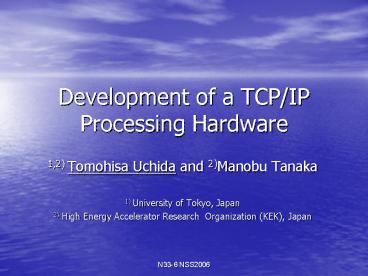Development of a TCPIP Processing Hardware - PowerPoint PPT Presentation
Title:
Development of a TCPIP Processing Hardware
Description:
Advantages using network technologies. Why we did develop? ... There are advantages using Network technologies. High Flexibility, High Connectivity, ... – PowerPoint PPT presentation
Number of Views:23
Avg rating:3.0/5.0
Title: Development of a TCPIP Processing Hardware
1
Development of a TCP/IP Processing Hardware
- 1,2) Tomohisa Uchida and 2)Manobu Tanaka
- 1) University of Tokyo, Japan
- 2) High Energy Accelerator Research Organization
(KEK), Japan
2
Outline
- Introduction
- Advantages using network technologies
- Why we did develop?
- Implementation
- A test board.
- Measurement
- Transfer Speed.
- Power Consumption.
- Conclusion
We call the hardware SiTCP.
3
Introduction
- There are advantages using Network technologies.
- High Flexibility,
- High Connectivity,
- Various Commodity Products,
- Standard OSs Support Standard Protocols,
- Easy Maintenance.
- It is essential in back-end systems
It has not been sufficiently adopted in
front-end systems.
4
Why did we develop ?
We Tried to adopt it but Encountered Problems.
- Front-end devices have constraints
- Small Hardware size,
- Low Power-Consumption,
- High Speed Data-Transfer.
In Order to Satisfy These Constraints, We Have
Developed SiTCP.
5
Features
- Small Hardware size
- Implemented on an FPGA
- Small Power Consumption
- lt 730mW
- System Clock is 25MHz with 100BAST-T.
- High Transfer-Speed
- Line Utilization of TCP data is about 95.
- Reach to The Theoretical Limit.
- Simple External Interface
- Like a Sync. FIFO-Memory-device.
6
Implementation
In order to measure performance, We developed a
Test board.
Ethernet PHY SMSC LAN83C185
FPGA
SiTCP on It
Xilinx XC3S500E
RJ45
2,000 Slices (40 logic resources) are used
Test Board
Small Size
7
Block Diagram of the FPGA
SiTCP
Test-Data Generator
Tx data
MII
Test-Data Checker
Rx data
Test data are incremental numbers.
MII (Media Independent Interface) is specified
by IEEE802.3.
8
Measurement
- Confirmed capability to communicate a PC
- Using a Linux OS.
- With a Simple Application Program
- Using Standard SOCKT() functions
- Receiving only
- Measured Transfer Speed
- From a SiTCP (Test board) to a PC
9
MeasurementSetup
ACK Logger
ACK Extractor
RS232C
Extracts TCP ACK s from packets
Send The Last TCP ACK Every 200 ms
A Packet is copied and Forwarded to The
Extractor.
Tap
Generates Test Data
RX-PC
100BASE-T
LINUX 2.4
Test Board
10
Calculate Line Utilization
- Transfer Speed
- Calculate from logged ACK s
- ACK is logged every 200 ms.
- Utilization Ratio
- Transfer-Speed / 100 Mbps
- (100BASE-T is employed)
11
Result
Reaches The Theoretical Limit
Theoretical Limit
Utilization Ratio ()
Power Consumption lt 730 mW (The whole board)
12
Conclusion
We have developed the TCP/IP processing hardware
(SiTCP).
- Enough Performance for Front-end Devices
- High-Speed Data Transfers
- 95 (Line Utilization of TCP data)
- Small Hardware Size
- 41 logic resources are used of XC3S500E
- Low Power Consumption
- lt 730 mW (The Whole Board)
SiTCP enables Front-end devices to adopt
Network-technologies.
13
Supplemental Slides
14
Sequence Number
All Data of TCP are numbered by a sender.
Data
SN2015
Data
SN2016
A TCP packet
Data
SN2017
Sending Order
Data
SN2018
Data
The sender sent a SN of first data.
SN2019
Data
SN3050
SN3051
15
Acknowledge Number
Data
SN2015
The Receiver is Expecting
Data
SN2016
A TCP packet
Data
SN2017
Receiving Order
Check the SN.
Data
SN2018
Data
SN2019
The Receiver sent back the expecting next SN As
ACK .
Data
SN3050
ACK 3051
SN3051
16
MeasurementSetup
ACK Logger
ACK Extractor
RS232C
Extract TCP ACK s from RX-PC packets
Send a TCP ACK Every 200 ms
A Packet is copied and Forwarded to The
Extractor.
Tap
Generates Test Data
RX-PC
100BASE-T
LINUX 2.4
Test Board
17
Transfer Capability TestTransfer Rates of Both
Directions
- Measured Transfer Speed
- Between SiTCPs
- Both directions
- Simultaneously
18
Capability TestTransfer Data of Both Directions
ACK Logger
RS232C
ACK Extractor
X 2
Ethernet Tap
100BASE-T
TCP Server
TCP Client
19
Line Utilization between SiTCPs
Avg. Utilization 95 (95 Mbps)
Stable
Server? Client
Client ? Server
20
Comparison toA Standard Implementation
- An Standard Implementation
- Using an FPGA
- Protocols are processed
- on an FPGA,
- Using an Embedded CPU,
- With a Standard OS
- Linux
- SUZAKU board
- One of the standard implementations.
21
SUZAKU board
- A Product of Atmark Techno Inc. ,Japan
- FPGA
- XC3S1000 (Xilinx Inc.)
- CPU
- Microblaze, Xilinx Inc.
- Embedded in an FPGA
- uClinux
Consists of an FPGA, an Ethernet Controller
chip, a Flash Memory, a DRAM.
22
Setup
ACK Logger
ACK Extractor
RS232C
Ethernet Hub
Ethernet Tap
100BASE-T
RX PC
SUZAKU board
23
Utilization Ratio
Max. Utilization 3
Utilization Ratio ()































